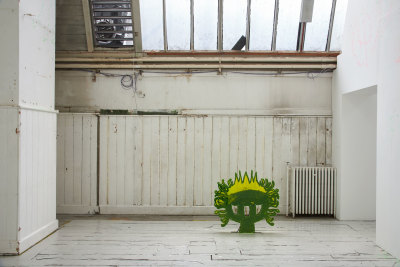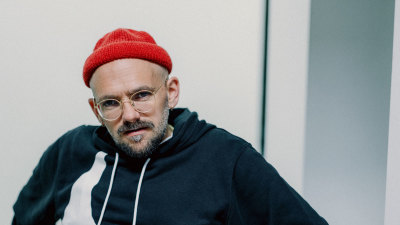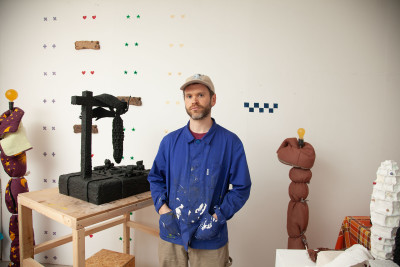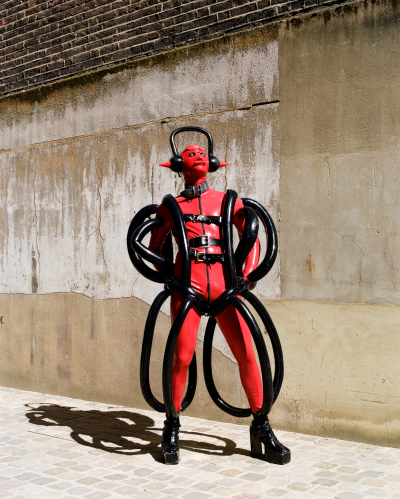An interview with Amy Petra Woodward
An interview with Amy Petra Woodward
By Jonathan Stubbs
Published 24 June 2014
The artist discusses her exhibition in the RA’s Gallery Café.
-
Amy Petra Woodward graduated from the RA Schools in 2013, and has since undertaken a residency at Unilever. She spoke to the RA’s Jonathan Stubbs about her current exhibition, YOU LOOK SO GOOD IN STEREO, on show in the Gallery Café at the RA.
Amy Petra Woodward I’ve presented a series of large works using reflective fabric, a surface of micro glass spheres, and print. For me, the attention-seeking properties of the reflective fabric parallel the way in which we look at things and in turn, what is demanded by any artwork or something “on show” — which asks the question: what are you looking at? The title of the exhibition itself is a reference to how we perceive things, and the role an artwork plays in the process of looking.
Jonathan Stubbs Your graduation show in the RA Schools studios had a very controlled use of light. How did you cope with the more challenging space in which this work is hung, where there are numerous other factors outside of your control?
-

Installation of view of Amy Petra Woodward's work in the RA Schools Show 2013
-
APW The emphasis in the degree show was the on the act of “doing” looking – the role the viewer plays, and maybe what to do with something presented to you. The direct lighting in the face of the viewer and controlled physical space was really important. Being manoeuvred into a response is provocative.
In YOU LOOK SO GOOD IN STEREO I have the work hanging on the wall – it’s a conventional painting hang, with standard lighting for that space. However, if you look at the work from a moving lift [the Sackler Wing glass lift passes through the Gallery Café], the surface shifts as the light changes.
JS The materials you use have reflective qualities and shifts in colour and texture. After viewing the work on several different occasions, it seemed to me that you could appreciate different aspects of the work throughout the day as the quality of light changed.
APW Yes — moving around the exhibition and viewing it at differing times of day reveals different aspects of the print surface. Pacing around and observing the shift from day to night are both instances I associate with having time to think.
I guess any static artwork looks different at different times — but that’s the point isn’t it! The cumulative effects of our personal experience and how we interact with our environment will affect how we perceive or interpret an artwork at any point in time.
JS Some of the works are also wall hangings, on extremely light material. It seems like the rippling of the surface is engaged in a struggle with the grid-like structure of the photography. Can you talk a bit about the material and how you reached the point where both the imagery and material pull together?
APW The reflective microspheres on this fabric are used for sportswear or high-visibility safety clothing — they are used to enhance awareness of a body, space or object and provide direction at moments of poor visibility. I’m interested in how I can upend an idea or see it in its inverse. The fabric makes the printed images have a version and an inversion that exists simultaneously: the darks in the images become light. The grid-like structure of images points toward sequence, order and collective data, but the texture of the fabric means this almost unravels.
In broader terms the fabric creates a space in which attention is demanded. I’m also thinking about how our awareness or attention has become a contemporary commodity—because persuading us to make choices is about targeting our attention. The images I use sit in this space of attention.
JS I’m curious as to what you are looking for when you bring together a sequence of images?
APW I’m looking for a conceptual riff: for the effect a group of images could have together — or at least being able to see a vacancy in the images for re-edit. For this exhibition I’ve presented the dance sequence from Polanski’s film Frantic from start to finish, with preliminary images of the appearance of a red dress on screen. The red dress is a visual reminder for those who have seen the film of the red dress worn by the missing character. I wanted to see the entire encounter: frame by frame, the dress appears again and again. For me, the red dress as a printed image stands for something missing-in-action or a conspicuous absence. Yet the collective image made from single 6x4 inch photographs also presents the red dress as more abstract visual information.
-

Installation view of YOU LOOK SO GOOD IN STEREO by Amy Petra Woodward in the Gallery Café, Royal Academy of Arts, 2014
-
The materials and images I use end up making the same gestures, one towards matter or structure, and one towards illusion, or non-matter. I was interested in the tragedy of this scenario - the illusion that there are two people close enough to each other to have an intimacy. But there is a flaw in this image - the way I have processed the Frantic dance sequence reveals for me a gory tragedy: the reality that two people can never be the same person.
JS Technically, they look like very challenging works to make. Can you explain a little about the process of discovering this method of printing?
APW Yes they are. For these works I stretch fabric over a large flatbed printer—a technique the printers and I have developed. We started working together six years ago and have tested a lot of materials! I have early works that were printed on marble and engraved slate. I also experimented with colour and with the amount of ink put down on the surface.
In terms of fabric, I now have sponsorship from JRC Reflex in France, who provide industry-only materials. I could never get hold of some colours otherwise—the super black reflective fabric in this exhibition is one example. I really love the hunt for new materials and seeing how they can collide with ideas. The technical side of my work is important but it is not isolated—working methods and the fantastic technical fabrics feed back into a conceptual approach to my artwork.
JS On leaving the Schools, where have you continued to make work, and how has this environment supported the production of the work?
APW When I left the RA Schools last year I was asked to start the first artist in residence programme at Unilever. I was researching areas for artworks including ecological language, viral language, epi-genetics, neurofeedback, neurolinguistics, optical brightening and disruptive colouration. I approached these research areas to open up my aesthetic language, and focused on how experience affects the body and brain. At the end of my residency Unilever acquired a large silver reflective fabric work printed with photographs selected from the time with them. In November later this year I have a solo exhibition at Chandelier Projects, a project directed by Karen Knorr and Daniel Campbell Blight.
JS How does an artist like you fit into the corporate structure of Unilever?
APW: I don’t think I did — and that was the idea! I was involved in the workshops happening at Unilever and had amazing discussions with scientists and the R&D department on their most recent and future research. I found it interesting to talk with them about what was perceived as ‘natural’ or ‘un-natural’ for example - especially mediated through technology or science. I think it would be a great project to help instigate more artists in residence to work with the research side of companies or businesses. It was definitely a reciprocal relationship for me and it would be fantastic if there were more opportunities like that for artists.
JS Finally, it would be good to hear a little bit about the RA Schools and your time there.
APW At the RA Schools we have very in-depth discussions about everyone’s practice. The effect of working and thinking as close-knit group is palpable — there is constant re-adjustment from the force of multiple agendas and vibrant, often conflicting voices. I always wonder how many voices there are existing in my work!
The RA Schools is a tough place. You are tough on yourself and others whilst trying to figure out or blow-up your practice — getting a developed understanding of what artwork you are making and learning how your ideas stand ground. But it’s tough love!
YOU LOOK SO GOOD IN STEREO is in the Gallery Café at the RA until 2 July.
Jonathan Stubbs is Patrons Manager at the RA.





